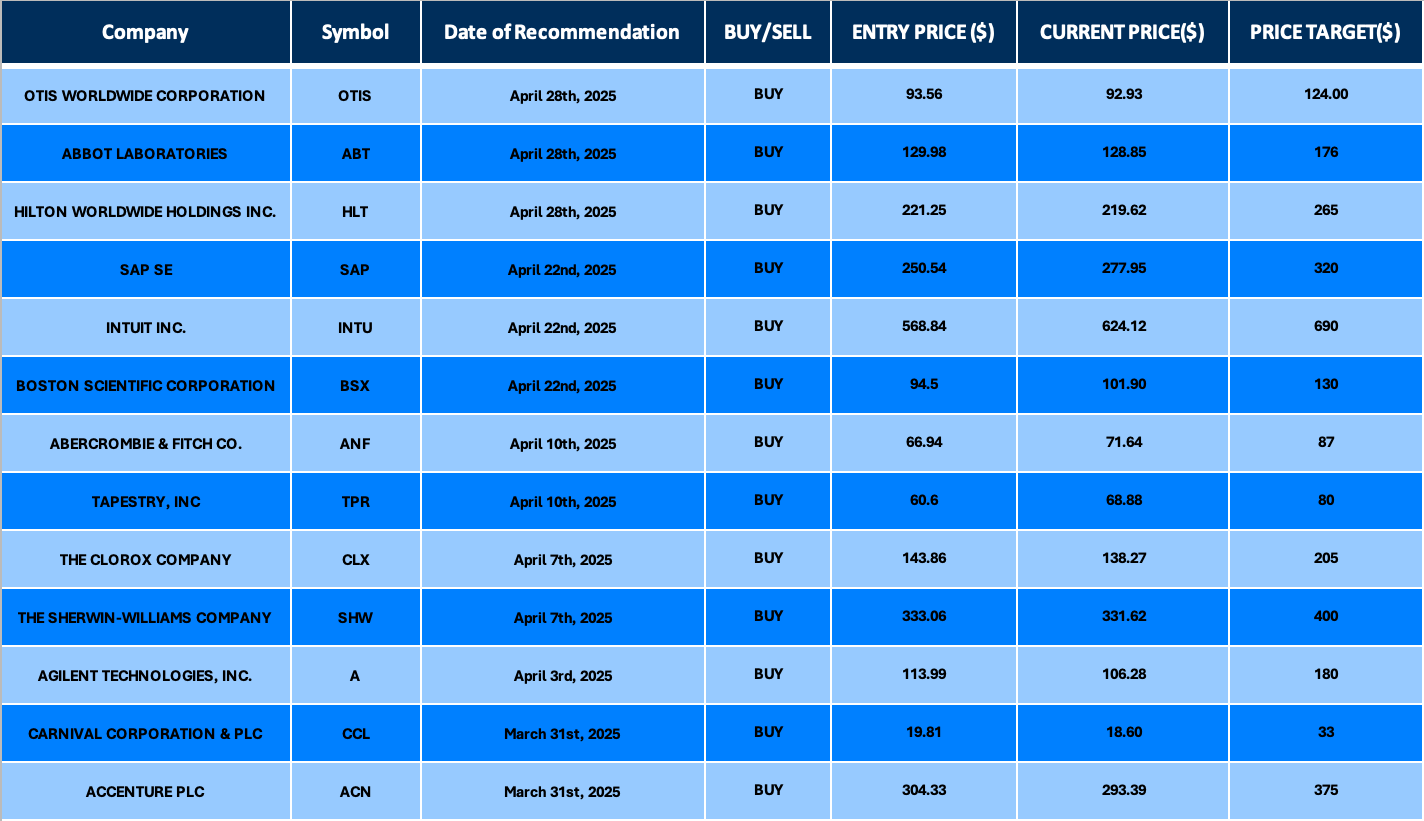
Date Issued – 2nd May 2025
Preview
Asian markets rallied on easing U.S.-China trade tensions, with Hong Kong’s Hang Seng jumping 1.8% and Wall Street extending gains on robust Big Tech earnings. Amazon exceeded Q1 earnings expectations, driven by strong cloud growth, but flagged tariff-related challenges, sending shares down 2% after-hours. Japanese investors increased foreign equity holdings for a sixth week, fueled by optimism over trade talks and a stronger yen. Shell’s Q1 profit dropped 28% but beat forecasts, maintaining its $3.5 billion share buyback plan. Meanwhile, the U.S. April jobs report is expected to reveal slower hiring and steady unemployment at 4.2%, as tariff uncertainty clouds the economic outlook. Investors are advised to diversify across AI-driven growth sectors, defensive assets, and international markets to navigate macroeconomic risks.
Asian Markets Climb Amid Hopes of Tariff Easing
Microsoft and Meta Platforms exceeded earnings expectations for the March quarter, underscoring the transformative role of artificial intelligence in driving revenue growth. Microsoft’s Azure cloud business surged 33% year-over-year, with AI services contributing 16% of the growth. Meanwhile, Meta’s advertising revenue, powered by AI innovations, rose 16%, pushing the company’s total revenue to $42.31 billion. Shares of Microsoft and Meta climbed 7% and 5.4%, respectively, in after-hours trading, reflecting investor confidence despite headwinds from Trump-era tariffs and regulatory challenges in Europe.
Investment Insight: The market’s rally underscores the impact of easing geopolitical tensions on investor sentiment, particularly in Asia. However, with ongoing concerns about U.S. stagflation and mixed corporate outlooks, investors should remain cautious. Diversify portfolios with exposure to sectors benefiting from AI-driven growth while hedging against macroeconomic risks by allocating to defensive assets such as high-quality bonds and dividend-paying equities.
Amazon Beats Earnings Expectations but Faces Uncertain Outlook
Amazon reported a strong first quarter, with a 9% revenue increase to $155.7 billion and earnings of $1.59 per share, exceeding analyst projections. Amazon Web Services led growth with a 17% sales increase, while investments in AI and cloud computing bolstered the company’s technological edge. However, CEO Andy Jassy flagged challenges ahead, including the impact of President Trump’s escalating tariffs and shifting consumer spending patterns. Amazon’s efforts to mitigate pricing pressure and expand rural delivery capabilities highlight its resilience, but second-quarter guidance fell slightly short of market expectations, leading to a 2% drop in after-hours trading.
Investment Insight: Amazon’s robust growth in cloud computing and AI signals sustained long-term potential, but macroeconomic uncertainties and tariff effects may weigh on near-term performance. Investors should focus on Amazon’s strategic investments in AI and logistics as key drivers of future profitability, while monitoring external risks tied to trade policies and consumer spending trends. Diversifying exposure across the tech sector could help offset volatility.
Market price: Amazon.com Inc (AMZN): USD 190.20
Japanese Investors Boost Foreign Stock Holdings Amid Trade Optimism
Japanese investors increased their foreign equity holdings for the sixth consecutive week, allocating a net 133.8 billion yen ($920.85 million), as optimism over U.S.-China trade negotiations and a stronger yen fueled overseas investment. Further bolstered by the MSCI World Index reaching a five-week high, investors also added 435.2 billion yen in long-term foreign bonds. Meanwhile, foreign inflows into Japanese equities slowed to 278.3 billion yen, and long-term Japanese bond purchases fell sharply to 60 billion yen, reflecting waning foreign demand.
Investment Insight: The sustained appetite for foreign equities among Japanese investors underscores the appeal of global diversification amid favorable currency movements and easing geopolitical tensions. Investors should consider leveraging this trend by increasing exposure to international markets with strong earnings momentum, while remaining mindful of potential shifts in bond demand and yen volatility.

Shell Q1 Profit Drops 28% but Outpaces Expectations
Shell reported a first-quarter profit of $5.58 billion, a 28% decline year-over-year but above analyst estimates of $4.96 billion. Lower oil prices and decreased refining margins weighed on results, with Brent crude averaging $75 per barrel compared to $87 last year. Despite the profit decline, Shell maintained its $3.5 billion quarterly share buyback program, contrasting with BP’s reduced buybacks. The company reiterated its trimmed annual investment plan of $20-$22 billion and highlighted stable performance in its gas trading segment, unlike BP, which faced headwinds in the same area. Refining margins improved sequentially to $6.2 per barrel but remained below last year’s levels.
Investment Insight: Shell’s commitment to shareholder returns through steady buybacks and disciplined capital spending underscores its resilience in a challenging energy price environment. Investors seeking stability may find Shell’s lower gearing and focus on LNG growth attractive compared to peers. However, continued pressure on oil prices and refining margins warrants cautious optimism for the sector. Diversifying energy holdings to include companies with robust gas and renewables exposure could mitigate volatility.
Market price: Shell PLC (SHEL): GBX 2,518.00
April Jobs Report Expected to Reflect Hiring Slowdown Amid Tariff Concerns
Economists project the U.S. economy added 125,000 nonfarm jobs in April, down sharply from 228,000 in March, with unemployment holding steady at 4.2%. The slowdown comes as businesses assess the impact of President Trump’s recent tariff policies, which have weighed on manufacturing activity and consumer sentiment. Despite signs of cooling, including a rise in weekly unemployment claims and near three-year lows in job openings, the effects of the April 2 tariff announcement may not yet be fully reflected in labor data. Wage growth is expected to remain stable, with average hourly earnings forecast to rise 3.9% year-over-year. Markets are pricing in a 60% chance of Federal Reserve rate cuts in June, reflecting heightened economic uncertainty.
Investment Insight: The anticipated slowdown in job growth highlights broader economic vulnerabilities tied to trade policy and weakening labor conditions. Investors should remain cautious, as weaker employment data could pressure equity markets. Positioning in defensive sectors, such as utilities and healthcare, may offer stability, while monitoring Federal Reserve policy shifts could provide insight into future market trends.
Conclusion
This week’s developments highlight the delicate balance between optimism and caution across global markets. Easing trade tensions buoyed Asian equities, while strong earnings from Big Tech lifted Wall Street. Yet, challenges persist, from Amazon’s tariff-related headwinds to Shell’s profit decline amid lower oil prices. Japanese investors’ appetite for foreign assets underscores the appeal of diversification, while the anticipated U.S. jobs slowdown reflects lingering economic uncertainty. As markets navigate geopolitical and macroeconomic risks, investors should focus on resilience—prioritizing sectors with growth potential, such as AI and renewables, while maintaining exposure to defensive assets to weather ongoing volatility.
Upcoming Dates to Watch:
May 2nd, 2025: Hong Kong GDP, EU Core CPI, EU Unemployment rate
Find below some of our Buy/Sell Recommendations. Balfour Capital Group is a distinguished global boutique investment management firm with $350 million AUM and over 1000 Clients.

Disclaimer: This post provides financial insights for informational purposes only. It does not constitute financial advice or recommendations for investment decisions.




